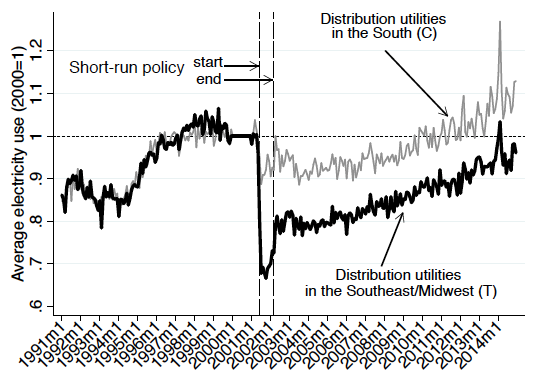
The welfare effect of policies aimed at changing behaviours persistently may be larger than usually measured because of 'hysteresis'
Many of our choices entail ‘externalities’, costs or benefits to others that we fail to take into account when making those choices. For example, our energy use is a major source of air pollution and greenhouse gas emissions. Yet, most of us do not factor in the full environmental impacts when making energy-related choices, creating a negative externality. As a result, in the presence of externalities, policies aimed at changing behaviours may be socially beneficial. These ‘corrective policies’ can take many forms: changing prices (e.g. gasoline taxes, home insulation subsidies), setting standards (e.g. fuel economy standards), restricting choices directly (e.g. driving restrictions as in Mexico City), or triggering changes in social norms (e.g. the ‘Don’t mess with Texas’ campaign).
Since Pigou (1920), economists have evaluated the desirability of corrective policies – their welfare effects – by comparing the social gains from changing behaviours (e.g. addressing the externalities from energy use), to their private costs (e.g. the loss in comfort from using less energy). When evaluating this trade-off, economists typically assume away the possibility of ‘hysteresis’, that a policy may affect choices persistently even if it is no longer in place. Yet, a growing body of research documents that temporary policies can have persistent effects on a range of behaviours (e.g. the adoption of new health or income-generating technologies, energy use, water consumption, smoking, commuting, voting) and some of the mechanisms behind these effects (e.g. investments in physical capital, learning, habit formation).1 In our paper (Costa and Gerard 2018), we study the importance of such hysteresis for the evaluation of corrective policies.
The Brazilian energy-saving programme
We begin by providing new evidence on the importance of hysteresis: we study the persistent (12-year!) impact of an energy-saving programme, which aimed at reducing residential electricity use by 20% over a 9-month period and affected millions of Brazilian households.
Energy use is expected to remain a major source of greenhouse gas emissions in the future and most of the growth is expected to come from the developing world (IPCC 2014). The rise in residential electricity use in particular is expected to be an important driver (Wolfram et al. 2012) and scenarios to mitigate climate change typically involve large reductions in electricity use by buildings (IPCC 2014). Yet, the energy-saving potential of households in developing countries is largely unknown. Moreover, despite the externalities, policies aimed at large changes in energy use are rarely implemented in practice (even in richer countries), because their private costs are often believed to be particularly high. As a result, we know little about the true costs of these policies.
The uniquely bold policy that we study was implemented because of a dramatic supply crisis. In the beginning of 2001, electricity generation capacity was severely reduced in some regions of Brazil. The country relied heavily on hydroelectric generation and an exceptional and temporary drop in the stream flow level of the rivers that serve the hydroelectric power plants in some areas of Brazil led to historically low water levels in their reservoirs. To avoid generalised blackouts, the government put in place a preventive energy-saving programme in affected areas. Between June 2001 and February 2002, households were assigned individual electricity use quotas that were about 20% below their own past consumption. The policy incentivised households to consume below their quotas by including fines and threats of power cuts for exceeding the quotas, bonuses for consuming below the quotas, and massive conservation appeals campaigns in the media.
Our study
In our paper, we estimate the short- and long-run impacts of this energy-saving programme. We use a difference-in-differences approach that compares areas subject to the policy to those that were exempt, before, during, and after the temporary policy was implemented.
Findings
Figure 1 presents our main result graphically. It displays the evolution of the monthly average residential electricity use per customer between 1991 and 2014 for all electricity distribution utilities in the southeast/midwest of Brazil, a region where the policy was implemented (treatment group), and in the South, a region where the policy was not implemented (control group). Trends were similar prior to the start of the policy in June 2001. Average consumption then dropped, particularly for distribution utilities in the southeast/midwest.2 It rebounded after February 2002, once the policy ended, but only partially: electricity use remained persistently lower in the southeast/midwest in all subsequent years!
Figure 1

Our analysis confirms the graphical evidence:
- The policy had a large short-run impact: a 23% short-run drop in consumption.
- Half of the short-run impact persisted in the long run: a 12% reduction in consumption until at least 2014, i.e. 12 years after the policy ended.
Robustness checks
In our analysis, we controlfor possible confounders, such as changes in electricity prices, demographics, or income levels. Further, using a synthetic control method, we find persistent effects for every single distribution utility subject to the energy-saving programme. Moreover, we complement our findings with evidence from longitudinal billing data for three million customers of one affected distribution utility and find that about one third to one half of the short-run effect of the quotas during the crisis persisted in the long run. Finally, surveys that asked households about their experience during and after the crisis suggest that an important mechanism of hysteresis in our context was a change in consumption habits.
Implications
In a second step, we highlight the welfare implications of hysteresis for corrective policies. We modify the textbook economic framework used to evaluate the welfare effects of corrective policies by allowing for hysteresis, for a policy in a specific period to also affect behaviours in subsequent periods. We show that hysteresis may have severe implications for the way economists evaluate corrective policies. Most importantly, in the presence of hysteresis, the private costs of policies aimed at persistent changes in behaviours may be much smaller than usually measured by economists. Moreover, the type of estimate that we obtained in our empirical analysis – the persistent effect of a short-run policy that was known to be short-run – can help illustrate the magnitude of this bias (it constitutes a ‘sufficient statistic’).
Consider a policy aimed at reducing electricity use by 23% over two periods. Assuming away hysteresis, an economist would evaluate this policy by calculating the private cost of reducing electricity use by 23% in the two periods separately. Now, suppose that the policy in the first period would lead to a 12% reduction in the second period, even in the absence of any policy or incentive in that period. The private cost of the policy in the second period is then much smaller because more than half of the reduction would be obtained without any additional cost. This simple intuition holds up when we extend the theory in multiple ways and is not specific to our application.
Finally, we illustrate these implications in the Brazilian context. We consider a hypothetical policy aimed at reducing electricity use by 23% over the whole period from 2011 to 2014. By failing to take into account the fact that the policy in the first nine months would have reduced electricity use by 12% in subsequent periods, even if the policy had ended, we find that a naïve analysis would overestimate the private costs of this policy by about US$7.75 billion. This bias is sizable: it corresponds to7.18% of all residential electricity bills over the same period!
Concluding remarks
Addressing the externalities from energy use is one of the most pressing challenges of our times and changing energy-related behaviours persistently is certainly costly. However, our study implies that one may severely overestimate these costs by failing to take hysteresis into account. This conclusion parallels recent findings that one may overestimate the damages from climate change – the other side of the trade-off – by failing to take adaptation into account (Barreca et al. 2016).
An exciting question that naturally arises from our findings, although beyond the scope of our paper, is which policies would best induce persistent changes in households' choices at an earlier stage of development to limit the growing energy demand in the developing world.
References
Acland, D and M Levy (2015), “Naiveté, projection bias, and habit formation in gym attendance”, Management Science 61(1): 146–160.
Allcott, H and T Rogers (2014), “The Short–Run and Long–Run Effects of Behavioral Interventions: Experimental Evidence from Energy Conservation”, American Economic Review 104(10): 3003–3037.
Barreca, A, K Clay, O Deschenes, M Greenstone, and J. Shapiro (2016), “Adapting to climate change: The remarkable decline in the US temperature-mortality relationship over the twentieth century”, Journal of Political Economy 124(1): 105–159.
Brandon, A, P Ferraro, J List, R Metcalfe, M Price, and F Rundhammer (2017), “Do The Effects of Social Nudges Persist? Theory and Evidence from 38 Natural Field Experiments”, NBER Working Paper 23277.
Bryan, G, S Chowdhury, and M Mobarak (2014), “Underinvestment in a Profitable Technology: The Case of Seasonal Migration in Bangladesh”, Econometrica 82(5): 1671–1748.
Charness, G and U Gneezy (2009), “Incentives to Exercise”, Econometrica 77(3): 909–931.
Costa, F and F Gerard (2018), “Hysteresis and the Welfare Effect of Corrective Policies: Theory and Evidence from an Energy-Saving Program”, NBER Working Paper, 24608.
Dupas, P (2014), “Short-Run Subsidies and Long-Run Adoption of New Health Products: Evidence From a Field Experiment”, Econometrica 82(1): 197–228.
Ferraro, P., and M. Price (2013), “Using nonpecuniary strategies to influence behavior: evidence from a large-scale field experiment”, Review of Economics and Statistics 95(1): 64–73.
Fujiwara, T, K Meng, and T Vogl (2016), “Estimating Habit Formation in Voting”, American Economic Journal: Applied Economics 8(4): 160–188.
Giné, X, D Karlan, and J Zinman (2010), “Put your money where your butt is: a commitment contract for smoking cessation”, American Economic Journal: Applied Economics 213–235.
IPCC (2014), Climate Change 2014: IPCC Fifth Assessment Report.
Ito, K (2015), “Asymmetric incentives in subsidies: Evidence from a large-scale electricity rebate program”, American Economic Journal: Economic Policy 7(3): 209–37.
Ito, K, T Ida, and M Tanaka (2017). “The Persistence of Moral Suasion and Economic Incentives: Field Experimental Evidence from Energy Demand”, American Economic Journal: Economic Policy.
Larcom, S, F Rauch, and T Willems (2017), “The benefits of forced experimentation: striking evidence from the London underground network”, The Quarterly Journal of Economics 132(4): 2019–2055.
Miller, C (2016), “The Persistent Effect of Temporary Affirmative Action”, American Economic Journal: Applied Economics 9(3): 152–190.
Pigou, A (1920), The Economics of Welfare, McMillan & Co.
Reiss, P, and M White (2008), “What Changes Energy Consumption? Prices and Public Pressures”, RAND Journal of Economics 39(3): 636–663.
Wolfram, C, O Shelef, and P Gertler (2012), “How Will Energy Demand Develop in the Developing World?”, Journal of Economic Perspectives 26: 119–138.
Endnotes
[1] See, for instance, Reiss and White (2008), Charness and Gneezy (2009), Giné et al. (2010), Ferraro and Price (2013), Allcott and Rogers (2014), Bryan et al (2014), Dupas (2014), Acland and Levy (2015), Ito (2015), Fujiwara et al. (2016), Miller (2016), Ito et al (2017), Brandon et al (2017), and Larcom et al. (2017).
[2] The smaller drop in the south was likely due to spillovers of the policy to unaffected areas.

